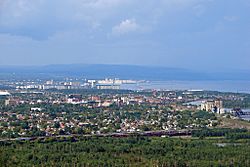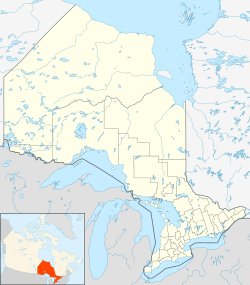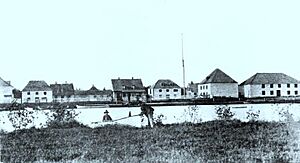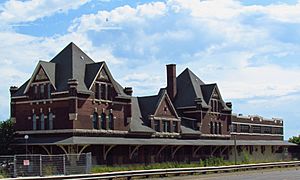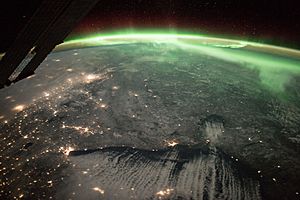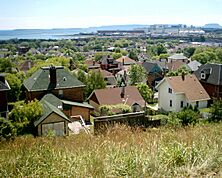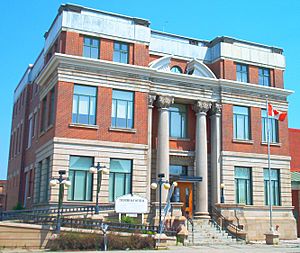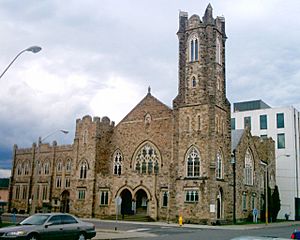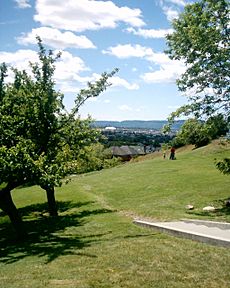Thunder Bay facts for kids
Quick facts for kids
Thunder Bay
|
|||||
|---|---|---|---|---|---|
| City of Thunder Bay | |||||
|
From top, left to right: view from Mount McKay, Lakehead University, Magnus Theatre, City Hall, Tourist Pagoda
|
|||||
|
|||||
| Nickname(s):
"Canada's Gateway to the West", "T-Bay", "Lakehead" or "The Lakehead"
|
|||||
| Motto(s):
Superior by Nature / The Gateway to the West
|
|||||
| Country | Canada | ||||
| Province | Ontario | ||||
| District | Thunder Bay | ||||
| CMA | Thunder Bay | ||||
| Settled | 1683 as Fort Caministigoyan | ||||
| Amalgamation | 1 January 1970 | ||||
| Electoral Districts Federal |
Thunder Bay—Superior North/Thunder Bay—Rainy River |
||||
| Provincial | Thunder Bay—Superior North/Thunder Bay—Atikokan | ||||
| Government | |||||
| • Type | Municipal Government | ||||
| Area | |||||
| • City (single-tier) | 447.5 km2 (172.8 sq mi) | ||||
| • Land | 328.24 km2 (126.73 sq mi) | ||||
| • Water | 119.0 km2 (45.9 sq mi) 26.6% | ||||
| • Urban | 179.38 km2 (69.26 sq mi) | ||||
| • Metro | 2,556.37 km2 (987.02 sq mi) | ||||
| Elevation | 199 m (653 ft) | ||||
| Population
(2021)
|
|||||
| • City (single-tier) | 108,843 (51st) | ||||
| • Density | 332.1/km2 (860/sq mi) | ||||
| • Urban | 95,266 (36th) | ||||
| • Urban density | 1,253/km2 (3,250/sq mi) | ||||
| • Metro | 123,258 (34th) | ||||
| • Metro density | 48.3/km2 (125/sq mi) | ||||
| Demonym(s) | Thunder Bayer | ||||
| Gross Metropolitan Product | |||||
| • Thunder Bay CMA | CA$6.2 billion (2020) | ||||
| Time zone | UTC−05:00 (EST) | ||||
| • Summer (DST) | UTC−04:00 (EDT) | ||||
| Forward sortation area |
P7A to P7G, P7J to P7K
|
||||
| Area code(s) | 807 | ||||
| NTS Map | 52A6 Thunder Bay | ||||
| GNBC Code | FCWFX | ||||
Thunder Bay is a city in Ontario, Canada. It is the biggest city in Northwestern Ontario. It is also the second largest city in Northern Ontario by population. In 2021, about 108,843 people lived there.
Thunder Bay is located on Lake Superior. The larger area around the city, called the census metropolitan area, has about 123,258 people. This area includes the city of Thunder Bay and nearby towns and townships. It also includes the Fort William First Nation.
Europeans first settled here in the late 1600s. A French fur trading post was built on the Kaministiquia River. Over time, Thunder Bay became a major shipping center. It helped move grain and other goods from western Canada. These goods traveled through the Great Lakes and the Saint Lawrence Seaway to the east coast.
In the past, forestry (working with forests) and manufacturing (making things in factories) were very important to the city's economy. These industries have become smaller recently. Now, the city is focusing on a "knowledge economy". This means jobs in medical research and education are growing. Thunder Bay is home to the Thunder Bay Regional Health Research Institute.
On January 1, 1970, the City of Thunder Bay was created. This happened when the cities of Fort William and Port Arthur joined together. They also included the townships of Neebing and McIntyre. The city is named after the huge Thunder Bay on Lake Superior. Old French maps from the 1700s called it Baie du Tonnerre, which means "Bay of Thunder." People often call the city the "Lakehead" because it's at the end of the Great Lakes shipping route on the Canadian side.
Contents
- Exploring Thunder Bay's Past
- Geography and Landscape
- People and Culture
- Economy and Work
- Thunder Bay Police Services
- Culture and Fun Things to Do
- Fun Places to Visit
- Sports and Outdoor Activities
- City Services and Connections
- Learning and Education
- Media and News
- Famous People from Thunder Bay
- Sister Cities
- See also
Exploring Thunder Bay's Past
Early Settlements and Fur Trade
Before Europeans arrived, different Anishinaabe peoples, like the Ojibwa, lived in the Thunder Bay area. French fur traders set up posts here in 1683 and 1717. These posts were later left empty. In 1803, the North West Company, based in Montreal, built Fort William. It became a main trading center in the middle of the continent.
By the 1850s, the Province of Canada started to look at its western lands. People found copper in Michigan. This made them interested in finding mining spots on the Canadian side of Lake Superior. In 1849, French Jesuits (a religious group) started a mission called Mission of the Immaculate Conception. They wanted to teach the Ojibwe people about their religion. In 1850, the Province of Canada signed the Robinson Treaty with the Ojibwa of Lake Superior. This treaty set aside an Indian reserve for them south of the Kaministiquia River.
Another settlement grew a few miles north of Fort William. This happened after a road was built connecting Lake Superior to the Red River Colony. This work was led by Simon James Dawson. In May 1870, Colonel Garnet Wolseley named this construction site Prince Arthur's Landing. The Canadian Pacific Railway (CPR) renamed it Port Arthur in May 1883.
Rival Towns and Growth
The arrival of the CPR started a long competition between Port Arthur and Fort William. This rivalry lasted until they joined together in 1970. At first, Port Arthur was much bigger. But the CPR, working with the Hudson's Bay Company, preferred east Fort William. This area was on the lower Kaministiquia River, where the fur trade posts were.
Because of a long tax fight with Port Arthur, the CPR moved all its workers and buildings to Fort William in 1889. After 1890, silver mining stopped, which hurt Port Arthur's economy. Port Arthur went through a tough time, while Fort William grew stronger.
In the early 1900s, Thunder Bay grew a lot. This was thanks to better access to markets by transcontinental railway and the growth of wheat farming in western Canada. The CPR added a second track to its line between Winnipeg and Thunder Bay. The Canadian Northern Railway built facilities in Port Arthur. The Grand Trunk Pacific Railway started building its facilities in Fort William in 1905. The government also began building the National Transcontinental Railway.
Many grain elevators were built as more grain was shipped to Europe. Both cities borrowed money to give rewards to manufacturing companies. Thunder Bay was the first city in the world to start daylight saving time on July 1, 1908.
By 1914, both cities had modern services. These included sewers, clean water, street lights, and electricity. Both Fort William and Port Arthur believed in cities owning their own services. In 1892, Port Arthur built Canada's first city-owned electric street railway. Both cities chose to set up their own telephone systems in 1902 instead of using Bell Canada.
Changes and Amalgamation
The good times ended in 1913–1914, made worse by the start of the First World War. The economy shifted to making war supplies and building ships. Many men from the cities joined the Canadian army.
Railway jobs were affected when the government took over some railways in 1915 and 1918. These were combined in 1923 to form the Canadian National Railways. This new company closed many railway facilities in Port Arthur. By 1929, the population of the two cities was back to pre-war levels.
The forest products industry has been important to Thunder Bay since the 1870s. Logs and lumber were mainly sent to the United States. In 1917, the first pulp and paper mill was built in Port Arthur. Another mill followed in Fort William in 1920. Eventually, four mills were working.
Manufacturing started again in 1937. The Canada Car and Foundry Company plant, which had built naval ships and railcars during World War I, reopened to build British aircraft. Today, this plant is run by Alstom. It still makes transportation equipment for cities, like for the Toronto Transit Commission.
On January 1, 1970, the City of Thunder Bay was officially formed. This was a merger of Fort William, Port Arthur, and two townships. The name was chosen by a referendum (a public vote) on June 23, 1969. People debated names like "Lakehead" and "The Lakehead." Because votes were split between these similar names, "Thunder Bay" won with a small lead.
The expansion of highways, like the Trans-Canada Highway, reduced railway and shipping activity after the 1970s. Shipping on the Saint Lawrence Seaway became less important as trucks took over. Grain shipping on the Great Lakes also decreased. Many grain elevators closed. The Kaministiquia River was no longer used by industry.
Thunder Bay Today
Thunder Bay is now the main service center for Northwestern Ontario. Most government departments have offices here. Lakehead University, started by local business people, is a big asset. Another college is Confederation College.
In the 2010s, Marina Park was developed as a place for tourists to visit.
Geography and Landscape
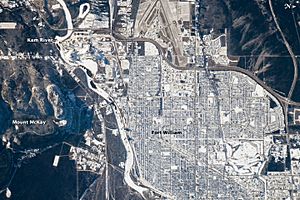
The city covers about 328.48 square kilometers (126.83 square miles). This area includes the old cities of Fort William and Port Arthur. It also includes the former townships of Neebing and McIntyre. The city is spread out, reflecting how it grew in the 1800s.
The western part of the city, called West Fort William (or Westfort), was surveyed in 1859–60. The land near the Kaministiquia River became the main living and business area of Fort William. A large empty area, known as Intercity, separated Fort William from Port Arthur.
The old Port Arthur area looks more like the Canadian Shield. It has gently sloping hills and thin soil over rock. Thunder Bay, which the city is named after, is about 22.5 kilometers (14 miles) from downtown Port Arthur to Thunder Cape. The old Fort William area is flat land along the Kaministiquia River. In the river's delta, there are two large islands: Mission Island and McKellar Island.
Since 1970, the main business areas of Fort William and Port Arthur have become less busy. Businesses and government offices moved to new areas in Intercity. Many new homes have also been built in the former Neebing and McIntyre townships.
City Neighbourhoods
Thunder Bay is made up of two cities that used to be separate: Port Arthur and Fort William. They still have their own unique feel. The Intercity area acts as a buffer between them. Both Port Arthur and Fort William have their own downtown areas and suburbs. Some neighborhoods include Downtown Fort William and Current River.
Thunder Bay's Climate
| Weather chart for Thunder Bay | |||||||||||||||||||||||||||||||||||||||||||||||
|---|---|---|---|---|---|---|---|---|---|---|---|---|---|---|---|---|---|---|---|---|---|---|---|---|---|---|---|---|---|---|---|---|---|---|---|---|---|---|---|---|---|---|---|---|---|---|---|
| J | F | M | A | M | J | J | A | S | O | N | D | ||||||||||||||||||||||||||||||||||||
|
31
-8
-19
|
25
-5
-18
|
42
1
-12
|
42
9
-2
|
67
16
2
|
86
22
8
|
89
25
11
|
88
24
10
|
88
19
6
|
63
11
-0
|
56
3
-7
|
38
-5
-15
|
||||||||||||||||||||||||||||||||||||
| temperatures in °C precipitation totals in mm |
|||||||||||||||||||||||||||||||||||||||||||||||
|
Imperial conversion
|
|||||||||||||||||||||||||||||||||||||||||||||||
Thunder Bay has a climate with warm summers and cold winters. The average daily temperature in July is 17.7°C (63.9°F). In January, it's -14.3°C (6.3°F). The highest temperature ever recorded was 40.3°C (104.5°F) on August 7, 1983. The coldest was -43.2°C (-45.8°F) on January 31, 1996.
On January 10, 1982, the wind chill made it feel like -58°C (-72°F). This is Ontario's record for the coldest day with wind chill. Thunder Bay gets a lot of sunshine, with over 2,100 hours each year. Winters are usually dry with not too much snow.
| Climate data for Thunder Bay Airport, 1981−2010 normals, extremes 1877−present | |||||||||||||
|---|---|---|---|---|---|---|---|---|---|---|---|---|---|
| Month | Jan | Feb | Mar | Apr | May | Jun | Jul | Aug | Sep | Oct | Nov | Dec | Year |
| Record high humidex | 9.2 | 15.4 | 22.9 | 29.7 | 38.7 | 43.1 | 46.2 | 45.4 | 41.2 | 32.3 | 21.7 | 11.8 | 46.2 |
| Record high °C (°F) | 8.3 (46.9) |
15.5 (59.9) |
23.8 (74.8) |
28.3 (82.9) |
35.2 (95.4) |
39.0 (102.2) |
40.0 (104.0) |
40.3 (104.5) |
34.1 (93.4) |
30.0 (86.0) |
21.7 (71.1) |
13.7 (56.7) |
40.3 (104.5) |
| Mean daily maximum °C (°F) | −8.0 (17.6) |
−5.0 (23.0) |
0.6 (33.1) |
9.2 (48.6) |
16.2 (61.2) |
20.6 (69.1) |
24.3 (75.7) |
23.3 (73.9) |
17.7 (63.9) |
9.9 (49.8) |
1.4 (34.5) |
−5.5 (22.1) |
8.7 (47.7) |
| Daily mean °C (°F) | −14.3 (6.3) |
−11.3 (11.7) |
−5.1 (22.8) |
3.0 (37.4) |
9.2 (48.6) |
13.9 (57.0) |
17.7 (63.9) |
16.9 (62.4) |
11.7 (53.1) |
4.5 (40.1) |
−3.2 (26.2) |
−10.8 (12.6) |
2.7 (36.9) |
| Mean daily minimum °C (°F) | −20.6 (−5.1) |
−17.7 (0.1) |
−10.7 (12.7) |
−3.2 (26.2) |
2.2 (36.0) |
7.1 (44.8) |
11.1 (52.0) |
10.4 (50.7) |
5.5 (41.9) |
−0.9 (30.4) |
−7.7 (18.1) |
−16.0 (3.2) |
−3.4 (25.9) |
| Record low °C (°F) | −43.2 (−45.8) |
−40.6 (−41.1) |
−36.7 (−34.1) |
−23.3 (−9.9) |
−8.9 (16.0) |
−3.9 (25.0) |
0.0 (32.0) |
−1.1 (30.0) |
−8.3 (17.1) |
−15.6 (3.9) |
−30.6 (−23.1) |
−39.6 (−39.3) |
−43.2 (−45.8) |
| Record low wind chill | −58.2 | −54.0 | −42.7 | −32.0 | −16.2 | −5.8 | 0.0 | −4.0 | −10.8 | −20.6 | −40.0 | −51.0 | −58.2 |
| Average precipitation mm (inches) | 26.3 (1.04) |
20.5 (0.81) |
31.3 (1.23) |
52.9 (2.08) |
67.0 (2.64) |
83.5 (3.29) |
87.0 (3.43) |
89.5 (3.52) |
73.1 (2.88) |
64.3 (2.53) |
53.1 (2.09) |
35.2 (1.39) |
683.7 (26.92) |
| Average rainfall mm (inches) | 0.39 (0.02) |
2.9 (0.11) |
16.1 (0.63) |
36.6 (1.44) |
66.3 (2.61) |
83.5 (3.29) |
87.0 (3.43) |
89.5 (3.52) |
72.0 (2.83) |
55.3 (2.18) |
30.7 (1.21) |
6.2 (0.24) |
546.5 (21.52) |
| Average snowfall cm (inches) | 36.5 (14.4) |
21.2 (8.3) |
18.2 (7.2) |
10.3 (4.1) |
1.0 (0.4) |
0.0 (0.0) |
0.0 (0.0) |
0.0 (0.0) |
1.1 (0.4) |
9.4 (3.7) |
26.5 (10.4) |
38.9 (15.3) |
162.9 (64.1) |
| Average precipitation days (≥ 0.2 mm) | 12.0 | 9.5 | 10.3 | 9.5 | 11.5 | 13.8 | 12.9 | 12.3 | 13.7 | 12.9 | 12.1 | 12.4 | 142.9 |
| Average rainy days (≥ 0.2 mm) | 0.57 | 1.1 | 3.4 | 7.1 | 11.0 | 13.8 | 12.9 | 12.3 | 13.5 | 11.0 | 4.7 | 1.2 | 90.7 |
| Average snowy days (≥ 0.2 cm) | 12.9 | 9.6 | 8.4 | 4.0 | 0.50 | 0.0 | 0.0 | 0.0 | 0.27 | 3.4 | 9.7 | 13.9 | 62.5 |
| Mean monthly sunshine hours | 109.6 | 126.7 | 159.8 | 213.0 | 259.0 | 262.0 | 268.1 | 255.9 | 163.8 | 125.4 | 86.2 | 91.2 | 2,120.5 |
| Percent possible sunshine | 40.1 | 44.2 | 43.4 | 52.0 | 55.0 | 54.5 | 55.2 | 57.6 | 43.2 | 37.2 | 31.0 | 35.0 | 45.7 |
| Average ultraviolet index | 1 | 1 | 3 | 4 | 6 | 7 | 7 | 6 | 5 | 2 | 1 | 1 | 4 |
| Source: Environment Canada Extremes 1877–1941, CBC and Weather Atlas | |||||||||||||
People and Culture
Population and Diversity
| Population history | |||||||||||||||||||||||||||||||||||||||||||||||||||||||||||||||||||||||||
|---|---|---|---|---|---|---|---|---|---|---|---|---|---|---|---|---|---|---|---|---|---|---|---|---|---|---|---|---|---|---|---|---|---|---|---|---|---|---|---|---|---|---|---|---|---|---|---|---|---|---|---|---|---|---|---|---|---|---|---|---|---|---|---|---|---|---|---|---|---|---|---|---|---|
|
|
||||||||||||||||||||||||||||||||||||||||||||||||||||||||||||||||||||||||
| Sources: | |||||||||||||||||||||||||||||||||||||||||||||||||||||||||||||||||||||||||
In 2021, Thunder Bay had a population of 108,843 people. This was a small increase from 2016. The average age of a person in Thunder Bay in 2016 was 43.3 years old. This is a bit older than the Canadian average of 41.0 years.
Thunder Bay is home to many different groups of people. It has the highest number of people of Finnish background in Canada. Many Indigenous people also live here, making up about 14.1% of the population.
| Selected ethnic origins, 2016 | |
|---|---|
| Ethnic origin | Population |
| English | 32,825 |
| Canadian | 27,850 |
| Scottish | 25,425 |
| Irish | 22,115 |
| French | 19,405 |
| Italian | 16,610 |
| Ukrainian | 16,085 |
| Indigenous | 15,670 |
| Finnish | 13,565 |
| German | 13,015 |
| Polish | 8,395 |
| Swedish | 5,360 |
| Visible minorities | 4,790 |
| multiple responses included | |
| Panethnic group |
2021 | 2016 | 2011 | 2006 | 2001 | |||||
|---|---|---|---|---|---|---|---|---|---|---|
| Pop. | % | Pop. | % | Pop. | % | Pop. | % | Pop. | % | |
| European | 83,620 | 78.41% | 87,030 | 82.71% | 92,300 | 87.12% | 95,270 | 88.8% | 97,520 | 90.8% |
| Indigenous | 15,055 | 14.12% | 13,490 | 12.82% | 10,085 | 9.52% | 8,845 | 8.24% | 7,250 | 6.75% |
| South Asian | 2,745 | 2.57% | 935 | 0.89% | 575 | 0.54% | 380 | 0.35% | 330 | 0.31% |
| East Asian | 1,490 | 1.4% | 1,155 | 1.1% | 1,020 | 0.96% | 1,285 | 1.2% | 535 | 0.5% |
| African | 1,185 | 1.11% | 665 | 0.63% | 485 | 0.46% | 435 | 0.41% | 425 | 0.4% |
| Southeast Asian | 1,135 | 1.06% | 870 | 0.83% | 770 | 0.73% | 625 | 0.58% | 560 | 0.52% |
| Middle Eastern | 625 | 0.59% | 515 | 0.49% | 170 | 0.16% | 80 | 0.07% | 215 | 0.2% |
| Latin American | 390 | 0.37% | 340 | 0.32% | 205 | 0.19% | 165 | 0.15% | 240 | 0.22% |
| Other | 400 | 0.38% | 235 | 0.22% | 350 | 0.33% | 205 | 0.19% | 245 | 0.23% |
| Total responses | 106,640 | 97.98% | 105,225 | 97.51% | 105,950 | 97.78% | 107,290 | 98.3% | 107,405 | 98.52% |
| Total population | 108,843 | 100% | 107,909 | 100% | 108,359 | 100% | 109,140 | 100% | 109,016 | 100% |
- Note: Totals greater than 100% due to multiple origin responses.
Languages Spoken
Most people in Thunder Bay speak English. Other common languages include Italian, French, and Finnish. Some Indigenous languages like Ojibwe and Oji-Cree are also spoken.
- Mother-tongue language (2016)
| Language | Population | Pct (%) |
|---|---|---|
| English | 90,135 | 86.1% |
| Italian | 2,815 | 2.7% |
| French | 2,405 | 2.3% |
| Finnish | 1,635 | 1.6% |
| Ojibwe | 920 | 0.9% |
| Polish | 830 | 0.8% |
| Oji-Cree | 660 | 0.7% |
Religious Beliefs
In 2021, about 56% of Thunder Bay residents were Christian. The largest Christian group was Roman Catholic. About 40% of people said they had no religion. Other religions like Hinduism and Islam are also present. Some residents follow traditional Indigenous spiritual beliefs.
Economy and Work
| Labour force | |||
|---|---|---|---|
| Rate | Thunder Bay | Ontario | Canada |
| Employment | 56.0% | 59.9% | 60.2% |
| Unemployment | 7.7% | 7.4% | 7.7% |
| Participation | 60.7% | 64.7% | 65.2% |
| As of: Census 2016 | |||
Thunder Bay is the main business and medical center for Northwestern Ontario. Many of the biggest employers are in the public sector. The City of Thunder Bay, the Thunder Bay Regional Health Sciences Centre, and the Government of Ontario employ many people. Resolute Forest Products is the largest private employer.
Alstom runs a large factory in Thunder Bay. It makes mass transit vehicles and equipment. This plant has been making railway cars and transit vehicles for a long time.
| Employment by Occupation, 2016 | ||
|---|---|---|
| Occupation | Thunder Bay | Ontario |
| Management | 8.1% | 11.3% |
| Business, Finance and Administration | 14.4% | 16.1% |
| Natural and Applied Sciences | 6.2% | 7.4% |
| Health | 10.0% | 6.4% |
| Education, Law, and Government | 14.5% | 11.9% |
| Art, Culture, Recreation, and Sport | 2.3% | 3.2% |
| Sales and Services | 30.7% | 23.4% |
| Trades, Transport and Equipment Operators | 15.0% | 13.3% |
| Natural Resources and Agriculture | 1.9% | 1.6% |
| Manufacturing and Utilities | 2.5% | 5.2% |
Some older industries, like forest products, have become smaller. This is due to new ways of doing things and higher costs. The grain trade has also decreased. This is because shipping methods have changed. Goods are now often moved by truck instead of by train and boat.
To grow its economy, Thunder Bay is trying to attract "knowledge-based" industries. These are mainly in molecular medicine and genomics. The city has the western campus of the Northern Ontario School of Medicine. This was the first new medical school in Canada in a long time. The city also has a law school.
Thunder Bay Police Services
The city's police force was created in 1970. It combined the police forces of Port Arthur and Fort William. It has over 200 police officers and six police centers.
Culture and Fun Things to Do

Thunder Bay was named a "Cultural Capital of Canada" in 2003. The city has many cultural centers. These represent its diverse population. Examples include the Finnish Labour Temple and the Italian Cultural Centre.
Two unique things started in Thunder Bay:
- The shag: This is a party that celebrates a couple's engagement.
- The Persian: This is a special cinnamon bun with pink icing.
The Thunder Bay Public Library has four branches. The city hosts events like Thunder Pride, an LGBTQ pride parade. It also has the annual Canadian Lakehead Exhibition.
Arts and Entertainment
Thunder Bay has many places for music and performances. The Thunder Bay Symphony Orchestra is the only professional orchestra between Winnipeg and Toronto. It plays classical music. The largest professional theater is Magnus Theatre. It puts on six plays each season. The Thunder Bay Community Auditorium is a big venue for various shows.
The Vox Popular Media Arts Festival is an independent film festival. It shows local, national, and international films. The North of Superior Film Association (NOSFA) also screens international and Canadian films. It organizes the annual Northwest Film Fest.
Museums and Galleries
The Thunder Bay Art Gallery shows works by First Nations artists. The Thunder Bay Historical Museum Society has local and traveling exhibits. It also has many old items, photos, and documents. Thunder Bay is also home to the Northwestern Ontario Sports Hall of Fame. The Thunder Bay Military Museum is located in the O'Kelley Armoury.
Two buildings in Thunder Bay are recognized as Federal Heritage buildings:
- Ordnance Store (recognized 1997)
- Park Street Armoury (recognized 1994)
Both are part of HMCS Griffin.
The Northwestern Ontario Aviation Heritage Centre collects and saves the history of aviation in the region. It has many items and photos, especially from the Canadian Car and Foundry factory. This factory made planes during World War II.
Places to Worship
Thunder Bay has many places of worship for different faiths. This shows the city's diverse culture. Some examples include:
- Assumption of the Blessed Virgin Mary Church – Ukrainian Orthodox.
- Calvary Lutheran Church – A Lutheran church.
- The Church of Jesus Christ of Latter-day Saints (LDS Church) – Has a family history library.
- Evangel Church – A Pentecostal Church.
- First-Wesley United Church – A large United Church built in 1910.
- Hilldale Lutheran Church – Offers services in English and Finnish.
- Holy Trinity Greek Orthodox Church – Helps provide housing for families in need.
- Kitchitwa Kateri Anamewgamik – A Roman Catholic church for Native culture.
- Lakehead Unitarian Fellowship – A Unitarian Universalist community.
- Redwood Park Church – A Christian Missionary Alliance church.
- Saalem Church – A Pentecostal church with services in English and Finnish.
- Shaarey Shomayim Congregation – A Jewish Synagogue.
- St. Agnes Church – A Roman Catholic church that runs a food bank.
- St Stephen the Martyr Anglican Church – Provides a food cupboard.
- St. John the Evangelist Anglican Church – An Anglican Church founded in 1872.
- St. Patrick's Cathedral – A Roman Catholic cathedral.
- St Paul's Anglican Church – A historic church built in the English Gothic style.
- St. Anthony's Parish – A Roman Catholic church.
- Thunder Bay Masjid – A Muslim mosque.
- Vedic Cultural Centre (ISKON) Thunder Bay – A Hindu temple.
Fun Places to Visit
Thunder Bay's main tourist spot is Fort William Historical Park. This is a rebuilt fur trade post from 1815. It gets 100,000 visitors every year. The marina in downtown Port Arthur, called The Waterfront District, is popular. It offers great views of the Sleeping Giant. You can also find trails, a playground, boat tours, and restaurants there.
There are small amethyst mines nearby. Some let visitors dig for their own crystals. A 2.74 meter (9 foot) statue of Terry Fox is located on the edge of the city. This is near where he had to stop his famous run across Canada.
Other fun places to visit:
- Bluffs Scenic Lookout
- Boulevard Lake Park
- Canada Games Complex
- Canadian Lakehead Exhibition
- Cascades Conservation Area
- Centennial Conservatory
- Centennial Park
- Chapples Park
- Chippewa Park
- Connaught Square
- Finnish Labour Temple
- Fort William Gardens
- Fort William Stadium
- Hillcrest Park
- Intercity Shopping Centre
- Kakabeka Falls
- Magnus Theatre
- Mission Island Marsh
- Mount McKay Lookout
- MV Miseford
- Northwestern Ontario Sports Hall of Fame
- Ouimet Canyon
- Prince Arthur's Landing waterfront district
- Port Arthur Stadium
- Silver Falls
- Thunder Bay Art Gallery
- Thunder Bay Community Auditorium
- Thunder Bay Historical Museum
- Thunder Bay Marina
- International Friendship Gardens
- Trowbridge Falls
- Waverley Park
Sports and Outdoor Activities
Thunder Bay is close to the wild Taiga forests and rolling hills of the Canadian Shield. This allows people to enjoy many outdoor activities. The city has hosted several big sports events, including:
- Summer Canada Games in 1981
- Nordic World Ski Championships in 1995
- Continental Cup of Curling in 2003
- U-18 Baseball World Cup in 2010 and 2017
- 2024 Women's Baseball World Cup (Group A and Finals)
Sports Facilities
Thunder Bay has many places for sports and recreation. The city runs fifteen community centers. These offer sports and fitness facilities. They also have seasonal activities like dances. The city also has six indoor ice rinks and 84 outdoor rinks. There are two indoor pools and three outdoor pools. The city also has several curling sheets and three golf courses.
Some of the city's main facilities are:
|
Multi-use facilities
Municipal ice rinks and indoor pools
|
Golf courses
Ski hills
Cross-country skiing facilities
|
Local Sports Teams
| Club | Sport | League | Venue |
|---|---|---|---|
| Thunder Bay North Stars | Ice hockey | Superior International Junior Hockey League | Fort William Gardens |
| Lakehead Thunderwolves | Basketball | Ontario University Athletics | C.J. Sanders Fieldhouse |
| Lakehead Thunderwolves | Baseball | National Club Baseball Association Div 2 (USA) | Baseball Central |
| Lakehead Thunderwolves | Ice Hockey | Ontario University Athletics | Fort William Gardens |
| Lakehead Thunderwolves | Volleyball | Ontario University Athletics | C.J. Sanders Fieldhouse |
| Thunder Bay Border Cats | Baseball | Northwoods League | Port Arthur Stadium |
| Thunder Bay Chill | Soccer | USL League Two | Fort William Stadium |
| Thunder Bay Kings | Ice hockey | Greater Toronto Hockey League | Fort William First Nation Arena |
| Kam River Fighting Walleye | Ice hockey | Superior International Junior Hockey League | Norwest Arena |
| Thunder Bay Kombans | Cricket | Northern Ontario Cricket League (NOCL) | Chapples cricket ground |
Thunder Bay is also home to the National Development Centre – Thunder Bay. This is an elite cross-country ski team. It attracts many of Canada's best young skiers.
Major Sporting Events
- Thunder Bay 10 mile road race
- 2010 World Junior Baseball Championship
- 2017 U-18 Baseball World Cup
- 2024 Women's Baseball World Cup
City Services and Connections
Transportation in Thunder Bay
Thunder Bay is a key spot for air, rail, and shipping travel. This is because of its great location on major routes.
The city has public transportation. Thunder Bay Transit runs 19 bus routes across the city. It also has limited service to the Neebing area and Fort William First Nation. Ontario Northland also offers bus services to nearby cities.
The city is served by the Thunder Bay International Airport. It is the fourth busiest airport in Ontario for aircraft movements. The Thunder Bay Regional Health Sciences Centre also has a helipad for helicopters.
The main highways are Highway 11/17 and Highway 61. They connect in Thunder Bay as the Thunder Bay Expressway. The Harbour Expressway connects the Intercity business area to the highways. Other important roads include Dawson Road (Hwy 102), Arthur Street, and Memorial Avenue.
Thunder Bay is an important railway hub. Both the Canadian National and Canadian Pacific Railway serve the city. Passenger train service to Thunder Bay stopped in 1990.
Thunder Bay Harbour
Thunder Bay has been a port since the time of the North West Company. The Port of Thunder Bay is the largest outbound port on the St. Lawrence Seaway System. It is also the sixth-largest port in Canada. The Thunder Bay Port Authority manages Keefer Terminal.
Hospitals and Health Care
Thunder Bay has one main hospital, the Thunder Bay Regional Health Sciences Centre. Other health services include the St. Joseph's Care Group. This group runs long-term care centers. The city also has many smaller medical and dental clinics. The main health authority in the region is the Thunder Bay District Health Unit.
Learning and Education
Thunder Bay has 38 elementary schools, three middle schools, and eight secondary schools. It also has two private schools and an adult education center. There are also private colleges and tutoring programs.
Higher education institutions include Confederation College, Northern Ontario School of Medicine (NOSM), and Lakehead University.
The Lakehead District School Board is the largest school board in the city. The Thunder Bay Catholic District School Board is the second largest. There are also French-language school boards that serve the city and surrounding areas.
Media and News
Print Media
Thunder Bay has one daily newspaper, The Chronicle-Journal. It covers all of Northwestern Ontario. The Chronicle Journal also publishes a free weekly paper called Spot. This paper focuses on entertainment. There are two weekly newspapers: Thunder Bay Source and Canadan Sanomat, which is in Finnish. Lakehead University has a student newspaper called The Argus. The city also publishes a newsletter for citizens called yourCity.
Television Channels
Three English-language stations provide free digital television in Thunder Bay. These include Global and CTV through Thunder Bay Television. The city also gets TVOntario on channel 9. CBC Television and Ici Radio-Canada Télé are available on cable and satellite.
Shaw is the cable provider in Thunder Bay. Tbaytel has also been approved to offer cable TV. The local community channel on Shaw Cable is called Shaw Spotlight.
Radio Stations
Thunder Bay has 12 radio stations, all on the FM band. There are four commercial stations: CJSD-FM and CKPR-FM (owned by Dougall Media), and CJUK-FM and CKTG-FM (owned by Acadia Broadcasting). Another station, CFQK-FM, also serves the Thunder Bay area.
The city receives CBC Radio One as CBQT-FM and CBC Music as CBQ-FM. The French Première Chaîne is available as a repeater of a Sudbury station. Lakehead University has a campus radio station, CILU-FM. CJOA-FM 95.1 broadcasts Christian-oriented programs. Thunder Bay Information Radio CKSI-FM is on 90.5 FM and is the city's emergency radio station.
Famous People from Thunder Bay
Sister Cities
Thunder Bay used to have five sister cities around the world. These cities were chosen for economic, cultural, and political reasons. In July 2023, the city council decided to end this program.
 Seinäjoki, Finland, since 1974
Seinäjoki, Finland, since 1974 Little Canada, Minnesota, United States, since 1977
Little Canada, Minnesota, United States, since 1977 Duluth, Minnesota, United States, since 1980
Duluth, Minnesota, United States, since 1980 Gifu, Japan, since 2007
Gifu, Japan, since 2007 Jiaozuo, China, since 2017
Jiaozuo, China, since 2017 Siderno, Italy
Siderno, Italy
See also
 In Spanish: Thunder Bay para niños
In Spanish: Thunder Bay para niños


